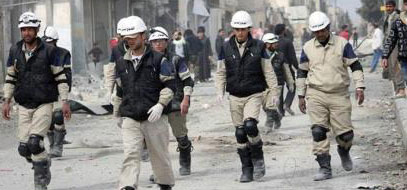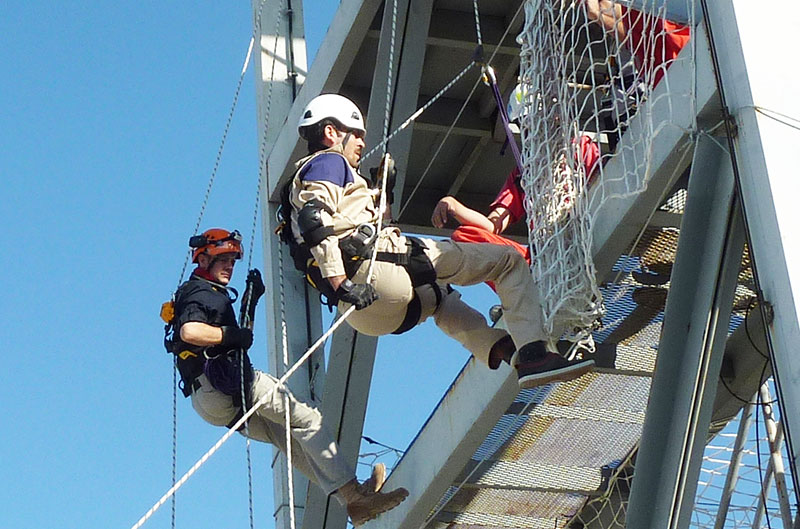Syria's Civil Defence: Bringing hope to beleaguered civilians
Syria: Just over a year ago, this volunteer from Northern Aleppo lost a leg to a barrel bomb in horrific circumstances while trying to rescue civilians trapped in rubble after bombing raids on their homes.
For months he fought despondency and depression as he battled to find the right treatment in a country whose medical infrastructure and other services have been eviscerated.
Last Friday, his first day back in uniform, Abdulmalek was cheered and clapped by his colleagues as he rappelled down a training tower.
He is part of one of Syria’s rare success stories, the Syrian Civil Defence: an unarmed volunteer rescue force with uncompromising neutrality at its heart, which could be the cornerstone of the future harmonious nation that most Syrians desperately hope will emerge from today’s darkness.

Turkey, about 50 miles from the Syrian border: We sit at wooden benches on a dusty training ground, a white awning providing some protection from the sun. A man banging a hammer on a metal propane fire simulator punctuates our conversation with noisy enthusiasm while instructors check the kit for this afternoon’s abseiling drills on the training tower. Everybody seems to be chain smoking.
The banter is familiar, the same as on fire or search and rescue grounds the world over; serious conversations interspersed with wry laughter. My lack of Arabic is no bar to picking up on the good-natured teasing between comrades.
These men are members of Syrian Civil Defence. Drawn from all backgrounds, they have all made the tough journey across the Turkish border for a gruelling ten-day rescue course.
James Le Mesurier, a British citizen at the heart of the initiative (see CRJ 9:4 and 10:1), explains why around 800 civil defence members, or White Helmets as they are known, have undertaken the dangerous trip into Turkey, often enduring harassment or extreme violence along the way.
“Towards the end of 2012, the regime escalated the level of attacks on so-called ‘liberated’ areas of Syria, particularly around Aleppo and Idlib. Anyone in these areas was considered to be a combatant; villages and towns were bombed regularly, heavily and without mercy,” he says.
“People were going to bed not knowing whether they or their families would survive the night. The only certainty was that if their house were to be struck, there was no hope that anyone would come to rescue them. Families knew they would lie trapped in the rubble of their homes until they died. There was a despondency, a complete absence of any kind of hope.”
The concept of the Syrian Civil Defence grew from meetings with American and British governments, along with the Syrian communities themselves. Initial seed funding, along with other international support, has helped to train these volunteers in urban search and rescue specific to conditions of war, as well as giving them basic emergency field medical instruction. They travel back to Syria with lightweight rescue equipment, a process also fraught with danger.
It was a challenge setting all this up without unintentionally reinforcing political or partisan groups, says James. But the founding ethos of the Civil Defence is neutrality – they will rescue and assist anybody in need, whatever their political affiliations. “We have dug out and rescued fighters from the regime,” a White Helmet tells me.
The volunteers despise zealots, are dismissive of politics and tired of factional rivalries. “Our only common enemy is the killing machine,” one notes grimly.
This unimpeachable impartiality has helped to propel the White Helmets to well-deserved heroic status in the communities they serve, as witnessed by the children who hang around their stations. “Before, the children played at war, now they play at being rescuers,” another volunteer comments.

Image of hope: This picture appeared in the last issue of CRJ.
Below: White Helmets look at the picture and laugh, recognising their children
The stories the volunteers tell are, unsurprisingly, harrowing in the extreme. A former English Literature student quietly describes how he and his team respond to several bombings a day, in between discussing his favourite play – Othello – with me. “Every day we see bombings, aircraft, shelling. We are on the front line. We see things worse than horror movies.”
He recounts locating victims in clothing factories, homes and schools, of blood and body parts, of screaming, mutilation, trauma, death. His smile is constant throughout the conversation, but his eyes tell their own story.
And I hear how our abseiling hero lost his leg, a gruesome tale of bombings, lack of medical care (the first two field hospitals he was taken to had neither equipment nor staff), followed by inadequate aftercare and a struggle to reach Turkey, without documents, to get a prosthetic leg fitted.

James and Abdulmalek abseiling down the training tower in Turkey on Abdulmalek's first day back in uniform after losing his leg to a bomb more than a year ago
He says he is telling his story to reach out to the rest of the world. “You must understand,” he emphasises, “We are the real Syrian people, not the ones you hear about in the news. We are totally against those who take and kill the people who come to help us. We just want to live, nothing else. And we thank everyone who helps us.”
James describes how this man was – and still is – an inspirational team leader, using his own car to respond when the area’s only fire engine was destroyed. A collection is being been held for a better prosthetic limb and the aim is to train Abdulmalek in command and control so he can continue his lifesaving mission.
Immediate needs are pressing for the Syrian Civil Defence. There are not enough personnel to deal with the constant barrage of barrel bombs and shelling; they are exhausted. More equipment suitable for local conditions and methods of construction is vital.
The hope that they give the population has not escaped the notice of the regime. Civil defence stations are bombed regularly. A few weeks ago they were provided with several vehicles. Within 24 hours, many of these were targeted and damaged by shells. Secondary bombing is a common tactic; with aircraft returning to attack sites once they know rescuers are on scene. At night, the White Helmets must work in the darkness, as torches or spotlights would make them sitting targets.
The White Helmets are a civilian, unarmed, apolitical humanitarian organisation. As such, James points out, “Any deliberate attacks on their teams or equipment are a violation of international humanitarian law under Article IV of the Geneva Convention, thus constituting a war crime.”
To date, 60 teams have saved more than 3,000 lives. But the toll has been heavy – 27 White Helmets have been killed.
Talking to the White Helmets, I see good people, ordinary people caught up in the bloody maelstrom of a truly brutal civil war, where civilians are slaughtered and their would-be rescuers targeted. These diverse, idealistic, fatalistic, heroic human beings of all ages were undergoing another eight days of gruelling training in Turkey.
Then they make the dangerous trip back to hell on earth.
- Emily Hough -
A complete article examining the type of training specific to wartime situations and how the SOPs were developed drawing upon post Cold War Civil Defence documents from the UK, as well as looking to future training and equipment needs, will be published in the next issue of Crisis Response Journal.
We will also be running the third and final article by James Le Mesurier, in which he discusses why civil protection bodies should be accorded far greater importance by the international community when rebuilding nations torn apart by war, and how this civil response model is transferable to other conflicts and troubled areas.
To help, visit www.whitehelmets.org or click here
Emily Hough, 10/10/2014